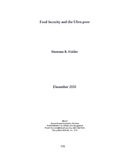| dc.contributor.author | Halder, Shantana R. | |
| dc.date.accessioned | 2019-09-11T09:42:37Z | |
| dc.date.available | 2019-09-11T09:42:37Z | |
| dc.date.issued | 2000-12 | |
| dc.identifier.citation | Halder, S. R. (2000). Food security and the ultra poor. Research Reports (2000), Economic Studies, (XVI), 135–150. | en_US |
| dc.identifier.uri | http://hdl.handle.net/10361/12548 | |
| dc.description.abstract | This paper aims to derive some policy guidelines by analysing factors affecting food
security of the ultra poor. Here more emphasis is given on the number of rice meals
taken and the sources of rice consumed during the last 24 hours. Results show that
only 17% of the ultra poor had the capacity to purchase rice for three meals a day.
Twenty percent had to depend on help from others. One-fourth had only one rice
meal, managed through any source. Food security was found to be highly correlated
with household landholding, adult literacy, household asset base, per capita income
and male female participation rate in the labour force. Differences in the level of
economic development of specific region also had significant effect on food security.
The disabled and elderly people are identified as a highly food insecure group. For
ensuring food creation of wage employment opportunities can help those who are
capable of working. For the elderly and disabled, there should be some provision of
safety nets. | en_US |
| dc.language.iso | en | en_US |
| dc.publisher | Research and Evaluation Division, Brac | en_US |
| dc.subject | Food security | en_US |
| dc.subject | Ultra poor | en_US |
| dc.subject.lcsh | Food consumption--Bangladesh. | |
| dc.subject.lcsh | Poverty--Bangladesh. | |
| dc.title | Food security and the ultra poor | en_US |
| dc.type | Research report | en_US |

